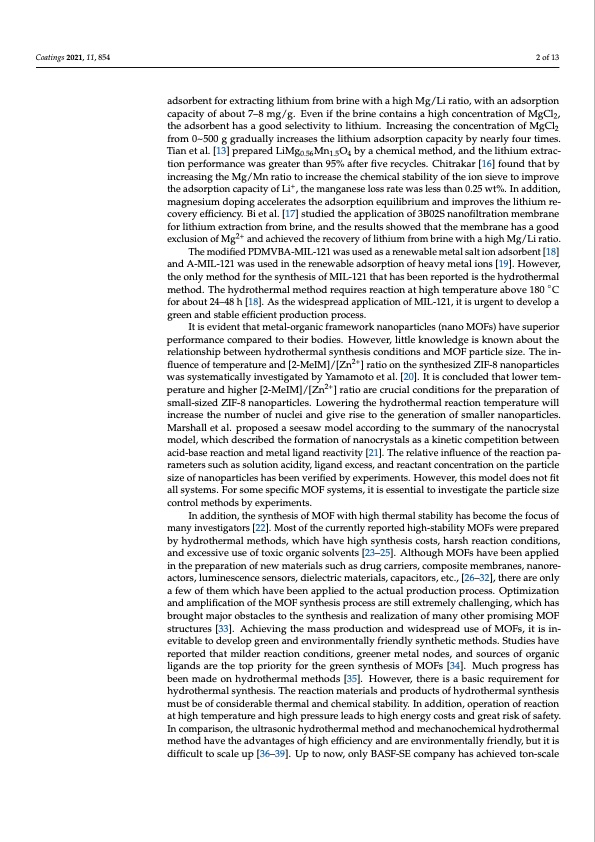
PDF Publication Title:
Text from PDF Page: 002
Coatings 2021, 11, 854 2 of 13 adsorbent for extracting lithium from brine with a high Mg/Li ratio, with an adsorption capacity of about 7–8 mg/g. Even if the brine contains a high concentration of MgCl2, the adsorbent has a good selectivity to lithium. Increasing the concentration of MgCl2 from 0~500 g gradually increases the lithium adsorption capacity by nearly four times. Tian et al. [13] prepared LiMg0.56Mn1.5O4 by a chemical method, and the lithium extrac- tion performance was greater than 95% after five recycles. Chitrakar [16] found that by increasing the Mg/Mn ratio to increase the chemical stability of the ion sieve to improve the adsorption capacity of Li+, the manganese loss rate was less than 0.25 wt%. In addition, magnesium doping accelerates the adsorption equilibrium and improves the lithium re- covery efficiency. Bi et al. [17] studied the application of 3B02S nanofiltration membrane for lithium extraction from brine, and the results showed that the membrane has a good exclusion of Mg2+ and achieved the recovery of lithium from brine with a high Mg/Li ratio. The modified PDMVBA-MIL-121 was used as a renewable metal salt ion adsorbent [18] and A-MIL-121 was used in the renewable adsorption of heavy metal ions [19]. However, the only method for the synthesis of MIL-121 that has been reported is the hydrothermal method. The hydrothermal method requires reaction at high temperature above 180 ◦C for about 24–48 h [18]. As the widespread application of MIL-121, it is urgent to develop a green and stable efficient production process. It is evident that metal-organic framework nanoparticles (nano MOFs) have superior performance compared to their bodies. However, little knowledge is known about the relationship between hydrothermal synthesis conditions and MOF particle size. The in- fluence of temperature and [2-MeIM]/[Zn2+] ratio on the synthesized ZIF-8 nanoparticles was systematically investigated by Yamamoto et al. [20]. It is concluded that lower tem- perature and higher [2-MeIM]/[Zn2+] ratio are crucial conditions for the preparation of small-sized ZIF-8 nanoparticles. Lowering the hydrothermal reaction temperature will increase the number of nuclei and give rise to the generation of smaller nanoparticles. Marshall et al. proposed a seesaw model according to the summary of the nanocrystal model, which described the formation of nanocrystals as a kinetic competition between acid-base reaction and metal ligand reactivity [21]. The relative influence of the reaction pa- rameters such as solution acidity, ligand excess, and reactant concentration on the particle size of nanoparticles has been verified by experiments. However, this model does not fit all systems. For some specific MOF systems, it is essential to investigate the particle size control methods by experiments. In addition, the synthesis of MOF with high thermal stability has become the focus of many investigators [22]. Most of the currently reported high-stability MOFs were prepared by hydrothermal methods, which have high synthesis costs, harsh reaction conditions, and excessive use of toxic organic solvents [23–25]. Although MOFs have been applied in the preparation of new materials such as drug carriers, composite membranes, nanore- actors, luminescence sensors, dielectric materials, capacitors, etc., [26–32], there are only a few of them which have been applied to the actual production process. Optimization and amplification of the MOF synthesis process are still extremely challenging, which has brought major obstacles to the synthesis and realization of many other promising MOF structures [33]. Achieving the mass production and widespread use of MOFs, it is in- evitable to develop green and environmentally friendly synthetic methods. Studies have reported that milder reaction conditions, greener metal nodes, and sources of organic ligands are the top priority for the green synthesis of MOFs [34]. Much progress has been made on hydrothermal methods [35]. However, there is a basic requirement for hydrothermal synthesis. The reaction materials and products of hydrothermal synthesis must be of considerable thermal and chemical stability. In addition, operation of reaction at high temperature and high pressure leads to high energy costs and great risk of safety. In comparison, the ultrasonic hydrothermal method and mechanochemical hydrothermal method have the advantages of high efficiency and are environmentally friendly, but it is difficult to scale up [36–39]. Up to now, only BASF-SE company has achieved ton-scalePDF Image | Small Particles for Lithium Adsorption from Brine

PDF Search Title:
Small Particles for Lithium Adsorption from BrineOriginal File Name Searched:
coatings-11-00854-v2.pdfDIY PDF Search: Google It | Yahoo | Bing
Product and Development Focus for Infinity Turbine
ORC Waste Heat Turbine and ORC System Build Plans: All turbine plans are $10,000 each. This allows you to build a system and then consider licensing for production after you have completed and tested a unit.Redox Flow Battery Technology: With the advent of the new USA tax credits for producing and selling batteries ($35/kW) we are focussing on a simple flow battery using shipping containers as the modular electrolyte storage units with tax credits up to $140,000 per system. Our main focus is on the salt battery. This battery can be used for both thermal and electrical storage applications. We call it the Cogeneration Battery or Cogen Battery. One project is converting salt (brine) based water conditioners to simultaneously produce power. In addition, there are many opportunities to extract Lithium from brine (salt lakes, groundwater, and producer water).Salt water or brine are huge sources for lithium. Most of the worlds lithium is acquired from a brine source. It's even in seawater in a low concentration. Brine is also a byproduct of huge powerplants, which can now use that as an electrolyte and a huge flow battery (which allows storage at the source).We welcome any business and equipment inquiries, as well as licensing our turbines for manufacturing.| CONTACT TEL: 608-238-6001 Email: greg@infinityturbine.com | RSS | AMP |